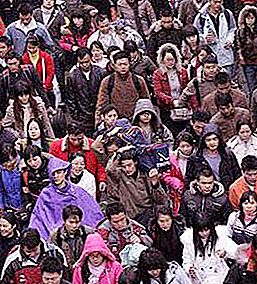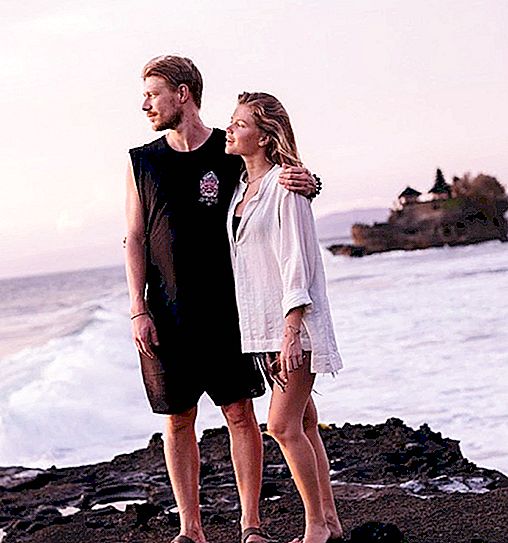The Mother's Monument is a well-known image that became especially often used after the Great Patriotic War. The most famous such sculptural work was installed in Volgograd on Mamaev Kurgan. However, over time, such compositions began to appear not necessarily in memory of the war, but also about other tragedies, for example, the monument to the grieving mother of the dead sailors, opened in Nakhodka.
Motherland

Still, the mother’s most famous monument was erected on the site of the Battle of Stalingrad, one of the decisive battles of World War II. This sculpture is the compositional center of the entire architectural ensemble on the Mamaev Kurgan. Today, this is one of the highest statues not only in Russia, but throughout Europe.
The sculpture is part of a composition of three parts. The first is in Magnitogorsk. At the Rear-to-Front monument, a worker hands over to a soldier a sword that was forged in the Urals to fight fascism. The third part of the composition is a monument to the soldier-liberator, who stands in Berlin. On it the sword, previously raised in Volgograd, is omitted.
Sculpture authors
Monument to the mother in Volgograd - the work of the sculptor Eugene Vuchetich and engineer Nikolai Nikitin. In the 70s, Vuchetich was vice-president of the USSR Academy of Arts, he himself participated in the Great Patriotic War. He owns both the monument to the warrior-liberator in Treptower Park and the monument “Swing swords at the screaming, ” which is installed in New York, near the United Nations building. He also installed the sculpture "Motherland" in Kiev in 1981.
The track record of Nikolai Nikitin is also rich. He is the developer of the foundations and supporting structures of many famous Soviet buildings. This is the Palace of Soviets, the main building of Moscow State University on the Lenin Hills, the central metropolitan stadium "Luzhniki", the Palace of Culture and Science in Warsaw, the television tower in Ostankino.
Majestic monument
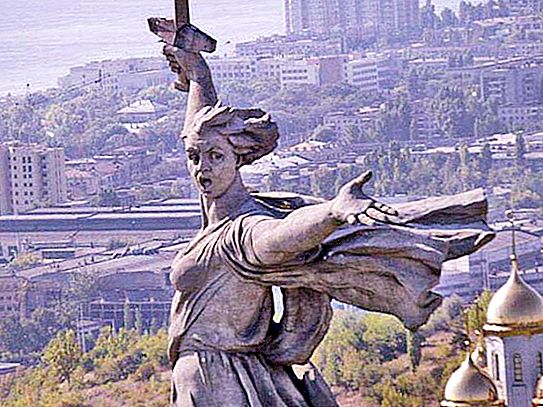
The monument to the mother of the work of Vuchetich and Nikitin is a figure of a woman who steps forward with a warlike appearance and a raised sword. This is an allegorical image. It contains the image of the Motherland, which calls on its sons to come together to fight the common enemy.
The construction of the statue began a decade and a half after the end of World War II - in the spring of 1959. Its creation took 8 years. At that time it was the tallest sculpture in the world. Until now, every night the sculpture is illuminated by spotlights.
Over the past time, restoration of the monument was required twice. And for the first time it’s quite early: 5 years after the official opening, the sword was replaced. In 1986, another large-scale restoration took place.
Prototype sculptures

Was there a prototype on the basis of which a monument to a woman-mother was created? There is still no single answer; there are only a few versions.
Most researchers believe that this is a graduate of the Barnaul Pedagogical School Anastasia Peshkova, who at that time was a little less than 30 years old. Also among the versions mentioned are Valentina Izotova and Ekaterina Grebneva.
A less popular, but also eligible version, says that the monument to the mother, whose photo is known to every Russian today, repeats the figure from the Arc de Triomphe in Paris. On its creation, in turn, the author was inspired by a statue of the Greek goddess Nika.
Specifications
In its height, the sculpture set a record among all existing at that time. The mother’s monument itself is 85 meters high, and another two meters is the installation plate. For this design, a concrete foundation was needed, buried to a depth of 16 meters. The height of the female sculpture itself (without a sword) is 52 meters. Its total mass is very impressive - more than 8 thousand tons.
The figure is made of reinforced concrete and metal structures. Inside it is hollow. Separately, it is worth staying on a sword. Its length is 33 meters. Weight - 14 tons. It is made of stainless steel, which is sheathed with titanium sheets.
Due to the deformation of the sword, the movement of titanium layers began, because of this, an unpleasant rattle of metal was constantly heard. For this reason, a few years after the installation of the sculpture, they decided to replace the sword. The new one consisted entirely of steel.
In order for such a design to remain constantly in service, the engineer, who is also its full-fledged author, worked pretty hard. The monument to the mother stands thanks to Nikolai Nikitin. He also calculated the stability of the Ostankino television tower.
Threat of collapse
In fact, immediately after the construction of the monument began to express concern that the monument to the mother could collapse. By and large, they have not ceased to this day.
Back in 1965, the State Construction Commission issued a conclusion according to which it was necessary to strengthen the main structures of the structure. Of particular concern was the monument "Motherland". The fact is that the foundation is installed on clay soils, which can eventually slide significantly towards the Volga.
The last large-scale survey of the monument was carried out in 2013. It was made by the capital's architect and sculptor Vladimir Tserkovnikov. In an open letter to the Minister of Culture Vladimir Medinsky, he reports that the foundation of the monument was made with significant errors that Nikitin made at the design stage. In his opinion, today he is in a deplorable state.
Kiev monument
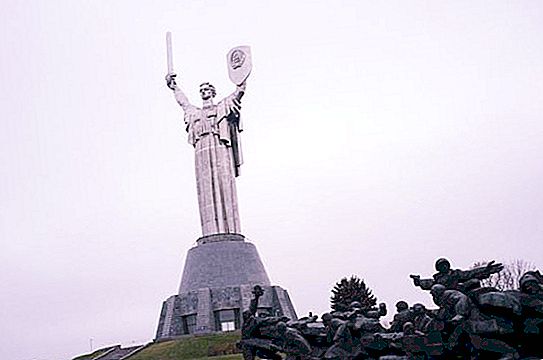
In the Ukrainian capital in 1981, a similar sculpture was opened. It is part of the composition of the museum of Ukrainian history about the Second World War. The architectural complex was opened on the 36th anniversary of the Victory over the Nazis, Leonid Brezhnev took part in the celebrations.
The author of the Volgograd sculpture, Evgeny Vuchetich, began working on the project. After his death in 1974, the project was led by Vasily Boroday. Just like Vuchetich, a veteran of the Great Patriotic War, a national artist of the USSR, who worked in the genre of socialist realism.
According to the calculations of specialists who made a description of the monument Motherland, the monument should stand for at least 150 years. It is made so reliably that it is able to withstand an earthquake of force even at 9 points. For example, in 1987 a powerful hurricane swept over Kiev, but the monument was not damaged.
The monument has observation platforms and two elevators, one of which moves at a slope of 75 degrees. Technical platforms and hatches are equipped in many parts of the monument. For example, one of them is right in the head of the Motherland.
Since 2002, sightseers climbed two viewing platforms - at an altitude of 36 and 92 meters. However, after the fall and death of a tourist from the upper level, non-specialists access to the monument was significantly limited.
Petersburg analogue

In Russia, the majority to the question: "Where is the monument to the Motherland?" they will answer that in Volgograd. But there are several more such sculptures. One of them is located in St. Petersburg.
The monument is located in the Piskarevsky cemetery. A female figure holds an oak wreath in her hands, which symbolizes eternity. The sculpture is located on a stone pedestal. Right behind it is a stone wall on which the famous words of the poetess Olga Berggolz are carved: "Nobody is forgotten, nothing is forgotten."
The work represents a grieving mother or wife whose face is turned to a mass grave.
Competition for this project was announced in 1945. It was decided to dedicate the memorial to the residents of Leningrad, who suffered the blockade and memory of the victims. Construction began only in 1956. The opening took place during the celebration of the 15th anniversary of the Victory - May 9, 1960.
The group of sculptors was led by Vera Isaeva, who died two weeks before the official opening of the monument. She suffered the blockade of Leningrad, participated in disguising the city during raids by enemy aircraft.
Mourning mother in Nakhodka
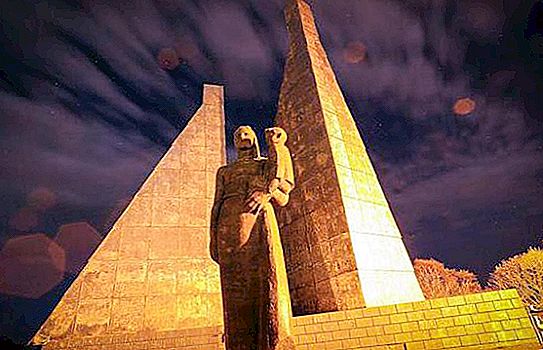
The history of the monument "The Sorrowful Mother" in the Far East of Russia is also quite sad. The Nakhodka Memorial was erected in 1979. The work is made of bronze.
The woman’s figure faces the Gulf of Nakhodka and is dedicated to the memory of the fishermen of the Boksitogorsk trawler, which crashed in the Barents Sea in 1965. The tragedy occurred in January during a storm, the strength of which was rated at 10 points. 24 crew members were killed. Only one managed to be saved happily - the master of mining from Boksitogorsk Anatoly Okhrimenko.
Behind the female sculpture, two ship sails are depicted. The names of all 24 dead sailors who their mother and wife did not wait for that year were stamped at the foot.
The project was led by Vladimir Remizov, the chief architect of Nakhodka.
Mourning mother in Bashkiria
A similar monument was installed in the capital of Bashkiria - Ufa. It is dedicated to soldiers and officers who died in various military conflicts, including local ones. A memorial was established near Victory Park.
The official opening took place in 2003. Its author was Nikolai Kalinushkin, Honored Artist of the Russian Federation.
The architectural composition resembles a religious building, and it was deliberately made so that it is impossible to understand whether it is Christian or Muslim. In it, on a low pedestal, a figure of a mother of bronze is installed.
Nearby are granite slabs on which the names of residents of Bashkortostan who died in local military conflicts are carved since 1951.


